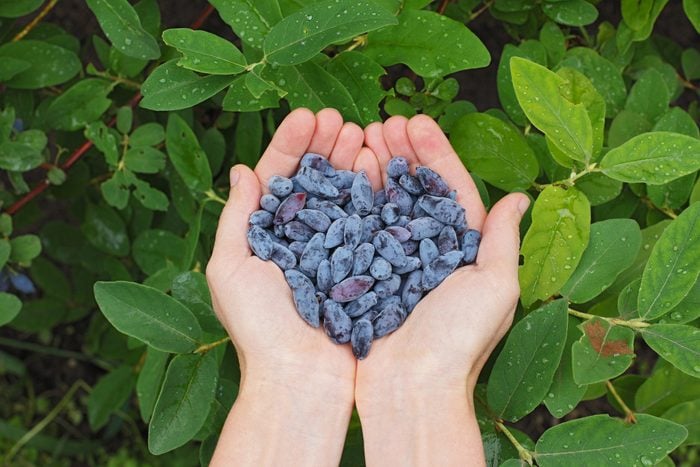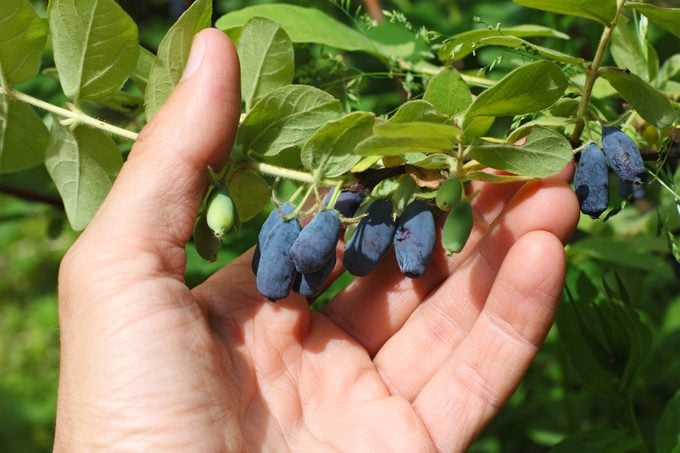What Is a Honeyberry?
Updated: May 31, 2023

For a delicious berry loaded with antioxidants that doesn't need acidic soil (like blueberries), grow cold hardy honeyberries. They taste like candy!
I planted two honeyberry shrubs several years ago. I love how easy they are to grow, and how delicious their fruit is. By early summer, they provide me with a few bowls of delicious dark blue honeyberries.
Everyone asks me what they are, whether they see their small yellow blooms in April, with fruit later, or just looking like a nice, healthy shrub.
On This Page
What Is a Honeyberry?
The botanical name for honeyberry is Lonicera caerulea. It’s a species of honeysuckle native to many regions of the Northern Hemisphere, including Europe, Russia, Asia and North America. In Japan, it’s known as haskap. It’s also called blue honeysuckle.
Most cultivars available today were developed in Russia and Japan.
What Do Honeyberries Taste Like?
Jason and Lucie Amundsen, owners of a pick-your-own honeyberry farm, Farm Lola in northern Minnesota, say honeyberries “[taste] like a blueberry had a baby with a package of SweeTARTS.” That’s a wonderful description.
Honeyberries can be tart, but are delicious mixed with other fruit, including strawberries. Honeyberries are also good as an ice cream topping, mixed into a smoothie or made into jam. Generally, whenever you might reach for a handful of blueberries, you can reach for honeyberries instead.
Where Do Honeyberries Grow?
Honeyberries are hardy in U.S. Department of Agriculture Plant Hardiness Zones 3 through 6, and some varieties will survive in Zone 2. They grow well in full sun in moist soil, and aren’t as fussy about soil pH as blueberries.
How To Grow Honeyberries

The Amundsens say you need two varieties to ensure good pollination because honeyberries don’t self-pollinate. They also recommend choosing two varieties that bloom around the same time. Most online nurseries will list which ones grow well together for good cross-pollination.
Planting
You can usually buy honeyberries as bare root cuttings or container-grown plants. For best results, plant as soon as you get them, at the same depth they were growing in the container. Keep watered until established, and mulch to prevent the soil from drying out too quickly.
Some honeyberries can grow to six to eight feet tall and five feet wide, so plant at least four to six feet apart in a row.
Pruning
Most honeyberries don’t require pruning in the first four to five years. They produce fruit on one-year-old wood, so buds were set the previous year for the berries you’ll get in early summer.
When honeyberries are dormant, lightly prune to remove broken stems. When your plants are older, you can prune some older branches to encourage new growth and to allow more sunlight into the shrub. That can improve fruiting.
Fertilizing
How much or how often you need to fertilize depends on your soil’s nutrient level. You may not need to fertilize at all. But if you’re concerned your honeyberries aren’t thriving, apply a general-purpose fertilizer in early spring, following the instructions on the label.
Controlling pests
Birds may be a problem, eating the fruit before you can pick it. On their farm, the Amundsens invite people to fly their drones and model planes above their fields to keep away cedar waxwing birds. In your garden, try reflectors and sound.
Honeyberries don’t have many insect pests. The Amundsens advise watching for the spotted wing drosophila, a type of vinegar fly introduced from Asia.
Late in summer, some honeyberry plants may be infected with powdery mildew. That can be controlled by ensuring good air circulation around the plants, then cleaning up dropped leaves in the fall.
Where to Buy Honeyberry Plants
Honeyberries are available from many online nurseries. Some favorite varieties at Lola Farms include:
- Aurora: Reportedly tastes like pop rocks candy.
- Indigo Gem: A Russian variety that’s sweeter and sometimes sold with Tundra for good cross-pollination.
- Wojtek: A Polish variety that’s sweet and tart.
Many nurseries, including Nature Hills, sell honeyberries. But they’re often sold out, especially in spring.
How To Harvest Honeyberries
Pick your honeyberries when they come off easily from the stem. For larger shrubs, place a tarp underneath and gently shake the plant. Ripe honeyberries will readily fall off.
Eat honeyberries fresh or keep them in the refrigerator for a few days. If you still have some left, clean and freeze them like blueberries.
